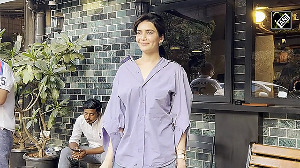The Reserve Bank of India first said that an Aadhaar letter containing name, address and Aadhaar number could be exclusively used as a 'know your customer' document for opening 'small' accounts, but later clarified that other accounts could also qualify, writes Subir Roy.  The disbursement of subsidies through direct cash transfers is round the corner.
The disbursement of subsidies through direct cash transfers is round the corner.
It will begin in 51 districts in the new year, just over a month away, and in half the country in four months' time.
So it is important to ask: do we have the capability to take on this job, and will it be a good thing?
Something new need not be fool-proof (virtually nothing in human affairs is) in order for it to be tried out. It is enough if a well-tested innovation is clearly superior to present practice, for it to be ushered in.
Innovations need to be tried out in various parts of the country as pilot projects; and those that are demonstrably functional should be adopted everywhere.
That's the way the Chinese go about ushering in innovations in policy and practice.
To answer the first of the two questions posed above, Aadhaar -- which will be at the core of the direct transfer process -- has so far performed creditably, both in speed of roll-out and reliability.
The technology of biometric recording of identity (10 fingers and iris) and the success of checking online for duplication have been found to be over 99 per cent accurate.
The technology may be OK, but what about the banking system through which the cash will be transferred?
The Reserve Bank of India first said that an Aadhaar letter containing name, address and Aadhaar number could be exclusively used as a 'know your customer' document for opening 'small' accounts, but later clarified that other accounts could also qualify.
But there is an issue over proof of address.
The clarification ends by saying that banks must continue to get proof of current address.
No wonder there is confusion among banks as to whether Aadhaar is a valid proof of address.
Cash transfer is dependent on access to a bank account.
According to a survey, not more than 18 per cent of rural Indians (28 per cent of rural men and a mere six per cent of rural women) have bank accounts.
Banks through business correspondents armed with micro-ATMs are seeking to bridge this gap.
But spreading financial inclusion
A finance ministry official has said that where there is no Aadhaar the voter's identity card can be used as a KYC document until Aadhaar coverage is complete.
Then why wait for Aadhaar at all?
Most importantly, so long as large numbers of villagers remain illiterate and unable to negotiate officialdom (banks are a part of that), there will be a role for touts -- hence the risk of the poor being deprived of a part of the cash.
The whole issue over proof of address is unreal.
The poorest Indians, pavement dwellers in cities and migrant labour from the countryside, have no residence worth the name.
For Aadhaar enrollment proof of residence can also be certified by a group leader.
But it would take some effort to use this route to cover most poor Indians without a proper residence.
And direct cash transfers, being speedily pushed through in the run-up to the 2014 elections, are meant to reduce inefficiencies in subsidising the poor.
Then, cash transfer is targeted at the poor -- but Aadhaar has no role in identifying the poor.
As has now been made explicit by the Union finance ministry itself, Aadhaar only established identity (eliminating fraud through misrepresentation and duplication).
Whether a recipient is really poor and whether most of the poor are included are separate issues.
So there are still big holes in efficiently distributing subsidies through direct cash transfer.
In some states, the size of below-poverty line lists looks absurd in comparison to their number of households.
Eliminating impersonation and duplication is a gain.
But how big is it, and is it enough to offset the doubts?
On whether direct cash transfer is a good thing, Harvard economics professor Abhijit Banerjee, who has done pioneering work in finding out what the poor want and how they have innovated, has asked whether they are good at spending cash.
The most obvious scenario that comes to mind is a head of household taking cereal money and spending it on country liquor.
But, considering the scale of leakage from the public distribution system, it is a net gain if this stops and a small fraction of the cash transferred gets misspent.
All this is not to say that direct cash transfer through Aadhaar is not a good idea, but to say that there is a long way to go before we can say that we have something going that is a distinct improvement over what has been the order of the day so far.













 © 2025
© 2025